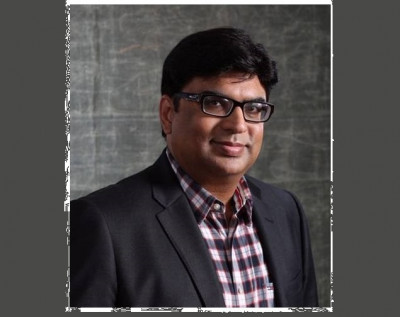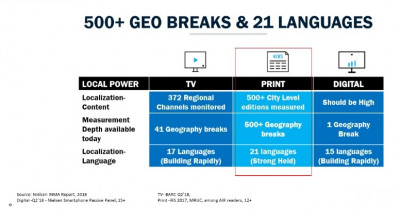Indepth: HT Media’s Rajan Bhalla decodes the new market realities of Print
The print industry has grown its audience base in the recent past, but radio and digital have grown at a faster pace and acquired scale. As a result, the industry is facing a sluggish growth phase of late as the various mediums like Digital, TV, Radio and Print compete with each other for audience’s time and advertiser’s budgets, writes Rajan Bhalla, Group Chief Marketing Officer, HT Media.
The readership growth has been healthy among the Indian language publications and relatively sluggish, but still positive, among English language publications.
Opportunities & Imperatives
A global scan of newspaper trends shows up 5 distinct opportunities and priorities being driven by many leading players – Print + Digital Interplay, Form Factor, Weekend offerings, Millennial and Women readers. These opportunities also resonate well with the rapidly evolving Indian society and economy.
A recent Reuters report for India suggests that the news in newspaper continues to be highly trusted and 5 out of top 7 sources for trustworthy news are newspaper brands. However, the newspaper offerings have not kept pace with the younger readers, is our learning from our own recent researches and hence, there is a need to relook at these key segments.
Millennials
Millennials are the largest segment of reader base and are moving towards accessing content online and reducing their time spent on reading newspapers. However, there are many positives that they still see in print, especially that news in print is authentic and presents verified information. Further, newspaper comes with detailed analysis, categorised well for their topic of interest and allows for focused reading, void of any distractions like pop-ups, links, etc.
Millennials face a tough and fast-paced life, and face many issues with newspapers in their current form. These issues include comprehension, user interface, navigation, look and feel issues. Hence, millennials are seeking different product formats and content mix. In addition, millennials want a weekend newspaper that they can read at leisure. It needs to be different from the weekday, and reflect the weekend vibe. They are firm believers of change and progress and their newspaper needs to reflect the same.
Gen Z
Digital mediums are very popular and print readership is comparatively lower amongst Gen Z, especially in metros. The barrier to Gen Z reading newspapers regularly is low perceived relevance, association with mature/ boring image, and serious content. Thus, a Gen Z newspaper is expected to be different from the main paper – at both product & image level and should look, feel and read different.
Customer-focused solutions
With the changing times, the need of advertisers has also changed as the media options have multiplied. Print for a long time was just talking about “How can I help deliver campaign reach”. However, the advertisers are more keen on client-centric solutions to address “How can we help solve your brand-problem”.
Further, there is an emerging need to highlight and strengthen “Why Advertise in Print” and not just “Why Advertise in my publication”. The inherent strategic benefits of print – reach, engagement, segmentation, innovation and credibility need to be leveraged to overcome the higher perceived cost of print.
Fast-evolving consumer and media landscape
- The consumer media usage landscape is shifting drastically. This is because millennials engage with their media at a much faster pace than in past years across multiple platforms.
- They’re exposed to an overwhelming amount of marketing messages and as a result, only engage with messages that are relevant to their needs.
- Gen Z are true digital natives: from earliest youth, they have been exposed to the Internet, to social networks, and to mobile systems. That context has produced a hyper-cognitive generation very comfortable with collecting and cross-referencing many sources of information and with integrating virtual and offline experiences.
- But herein lies the opportunity for every medium to adopt a more omni-channel approach. A multi-channel approach to marketing, selling, and serving customers in a way that creates an integrated and cohesive customer experience, no matter how or where a customer reaches out. A few ways to create this approach with print is usage of QR Codes as well as including social media handles and migration platforms on print materials to interact with audiences.
- 61% of Gen Zers believe their peers would benefit from unplugging more. Even though they grew up with technology, they see the value in print media and unplugging when consuming content. According to research from MNI, “Gen Z may breathe new life into print – preferring to use newspapers and magazines [without] interruption and trusting these publications over other media to deliver credible information.”
Print Matters (Relevance of Print)
- Reach: Approximately 450 million readers
- Segmentation: Geo targeting is a big strength of print. 910 publishing centers across India. Over 150 editions in Hindi belt of Hindustan vs < 10 beams of one TV channel
- Credibility: Highest credibility across media. In a Twitter poll, 74% trusted ads in Print vs Digital at 26
- Drives Memory: Research has shown that people read more slowly when reading on paper than online. This is a big benefit of print media, because slower reading allows you to gain deeper understanding. Just holding the paper is a tactile exercise that helps the brain form connections that increase memory.
- Has Staying Power: Unlike internet advertising that readers often must click on to read, or social media advertising that comes and goes, print media advertising stays where it’s put. The staying power of print gives print advertisers an aura of strength and solidity.
- Builds Awareness: All types of advertising require repeat placement to be effective. But, while TV and online campaigns show diminished awareness of an advertiser or brand after running four times, awareness continues to grow with the frequency of print ads. Print media advertising are known to increase brand loyalty and purchase decisions far more than online ads do.
- Combine Media for Greatest Impact: Look at any print ad’s closing paragraph, and you’re likely to see a redirect to a website for more information or a special offer. That’s because print is exceptionally good at driving readers to wherever you want them to go. Every advertising medium has its benefits. For maximum impact, a marketing campaign should be an integrated one that makes use of different types of media, each reinforcing versions of your message. TV ads have been proven to achieve twice as many results when paired with print than when paired with online ads only. Combining all three is even more effective. With a multimedia approach, you not only reach people who prefer one medium over another; you also increase awareness and, in the long run, increase and maintain brand loyalty.
- Engagement: Loyal & exclusive readers. Average papers 1.8, 3hrs/week (highest concentrated time). TV 35 channels, 20hrs/week. Digital 21 apps 18 hours a week.
- Innovation: A proven platform for innovation.
However, print measurement continues to pose a challenge
Print measurement remains a challenge. Right or wrong, TV & digital platforms provide metrics for assessing Reach, Relevance & Impact. Print falls short today in measuring targeted impact. Print works, but there is no data point except a customer’s own measurement. Regular reporting of IRS should help in this direction. However, creating custom contact information, using discount & coupon codes and measuring web traffic are some effective ways of using digital methods to measure print. Why else would large online players bank on print advertising when they have ‘big days’ to deliver.
Business model requires a re-pivot, ramping up digital revenues an opportunity
- Media revenues and profits are largely dependent on advertising revenues with share of advertising revenues hovering at the 45 per cent mark. The business models will have re-pivot. In the case of print, this ratio is further adverse with 10-15 per cent of revenue coming out of circulation sales and dependence on advertising revenue is almost 80-85 per cent.
- Currently, digital revenues make up ~5-7 per cent of the print revenue. Bulk of the digital revenue is mopped up by Google and Facebook. News itself is sub 20 per cent of digital consumption.
- In a connected omni-channel world, with high-quality journalism and superior content, subscription-based revenue can help boost digital revenues on the back of print.
Excited there is a future. Future problems with past solutions will not work
- There needs to be a sharp focus on winning content across sharply segmented cohorts. Hyper local play for print is a strength that it needs to build on.
- Technology is the other key factor that will make or break business models. It spans all the way from digitisation to digitalisation to transformation.
- While it’s important for legacy print companies to energise the core print business, they need to equally focus on creating platforms of the future.
- Companies need to have a clearly defined strategy on millennials as well as GenZ to address today’s needs and be future ready.
- Legacy print companies will need to create a fine balance between investment in print Vs technology led future platforms.
- Customers would increasingly seek business solutions as opposed to buying vanilla display advertising. This will require an ecosystem of very differently trained and enabled sales force to keep up with integrated platforms that enable delivery of Reach, Relevance or Impact.
- Data analytics will also be a core enabler and in certain ways a core competency that companies would need to build out for superior internal & external actions.
- Print companies will also need to focus hard on creating the most efficient cost structures to combat the headwinds on revenue.
- Finally, the print companies should come together to jointly bring back the mojo in print through evangelisation of print amongst the customers.









Share
Facebook
YouTube
Tweet
Twitter
LinkedIn